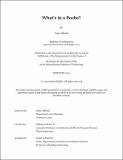What’s in a Poche?
Author(s)
AlMulla, Nada
DownloadThesis PDF (15.95Mb)
Advisor
O’Brien Jr., William
Terms of use
Metadata
Show full item recordAbstract
Where did it come from? And how was it acquired?
In the wake of an increased desire for restitution, set against perpetual efforts of claiming and reclaiming, governmental entities begin to actively take a stance on unearthing looted cultural properties and responding to repatriation requests.
Through the design of architectural moments that allow artifacts to covertly emerge from and disappear into the poche, the project addresses the issue of repatriation, and imagines a space located beneath the National Archives building in Washington D.C., adding to the fabric of secret underground tunnels in the National Mall. The below-ground facility will act as a transitional space where repatriated art will be securely housed before it is transported back to its home country.
Historically, the solid mass in a poche referred to the necessary structure in masonry buildings, as well as the unique articulation of interior spaces and buffer zones that are different from the exterior. On some occasions, It was also used as an indication of hidden spaces, such as servant corridors.
Since the problem of structure is rendered void by the paradigmatic shift in modern technology, it is no longer necessary to build thick walls with a solid mass of material. That leaves both the flexibility of articulating each interior space distinctly, and the creation of secret and concealed spaces as ways to adapt poche in contemporary architecture.
The project is interested in exploring Architecture’s ability to operate beyond its traditional requirements to incorporate affective qualities such as obscurity and mystery through the design and organization of a space, and the adaptation of reclaimed or contemporary poche.
Date issued
2023-02Department
Massachusetts Institute of Technology. Department of ArchitecturePublisher
Massachusetts Institute of Technology